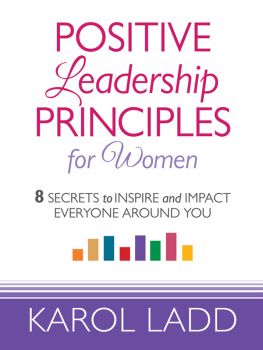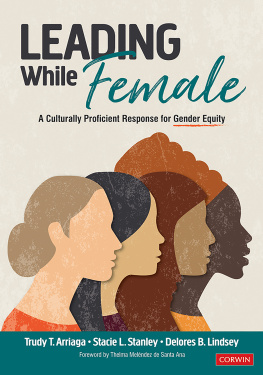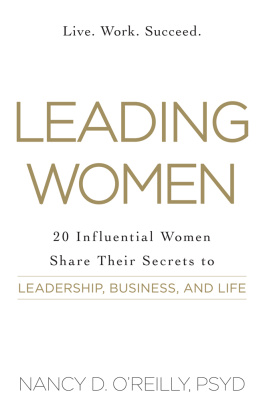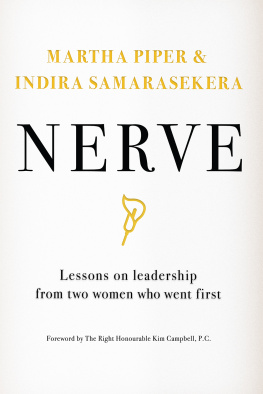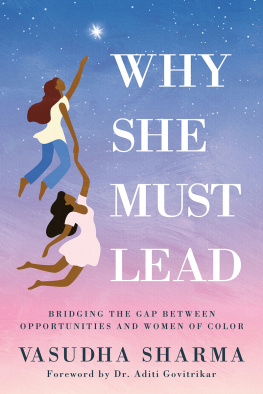Christine Nixon and Amanda Sinclair have written a terrific book
which contains great advice for women to own and manage our
lives and careers. It should be compulsory reading for girls (and
boys!) and for people of all ages. It doesnt aim to find one theory
or smart phrase about womens lives, but, using humour and
practical ideas, gives all of us insights into the issues women face as
we navigate our way through life.
Elizabeth Proust AO,
Chair of the Australian Institute of Company Directors
WOMEN LEADING
WOMEN LEADING
CHRISTINE NIXON
AND AMANDA SINCLAIR

MELBOURNE UNIVERSITY PRESS
An imprint of Melbourne University Publishing Limited
Level 1, 715 Swanston Street, Carlton, Victoria 3053, Australia
www.mup.com.au
First published 2017
Text Christine Nixon and Amanda Sinclair, 2017
Design and typography Melbourne University Publishing Limited, 2017
This book is copyright. Apart from any use permitted under the Copyright Act 1968 and subsequent amendments, no part may be reproduced, stored in a retrieval system or transmitted by any means or process whatsoever without the prior written permission of the publishers.
Every attempt has been made to locate the copyright holders for material quoted in this book. Any person or organisation that may have been overlooked or misattributed may contact the publisher.
Text design and typesetting by Megan Ellis
Cover design by Design by Committee
Printed in Australia by McPhersons Printing Group
National Library of Australia Cataloguing-in-Publication entry
Nixon, Christine, 1953 author.
Women leading/Christine Nixon, Amanda Sinclair.
Leadership in women.
Women executives.
WomenSocial conditions.
Other Creators/Contributors: Sinclair, Amanda, 1953 author.
9780522871623 (paperback)
9780522871630 (ebook)
Includes index.
Contents
Introduction
If leadership is about initiating and mobilising change, we have much to learn from women. Throughout history and across societies and cultures, women have developed ways of challenging the status quo, of voicing their interests, and of influencing families, workplaces, communities and nations to become more humane, equitable and inclusive. Because of the intractability of obstacles, women have had to find ingenious pathways to influence and reliable means to sustain themselves and others when encountering setbacks. Women have had to maintain energy and spirit not just over lifetimes but also across generations.
We believe leadership by women has not been adequately recognised, and this book sets out to learn how, and to what ends, women lead. Both of us, Amanda and Christine, have grown frustrated at the narrow approaches that miss the rich diversity of womens leadership. Some research on business leadership paints women as not more, be more ambitious or claim credit for achievements. Based on our experience and research, we believe the opposite to be true. Womens skills, capacities, merit and leadership qualities exist but have not been acknowledged by mainstream writers as leaders to learn from. We want to change that: to throw the spotlight on how women have been and are leading, innovatively and sustainably, across a diverse range of contexts. Especially as agents of disruption and doing leadership differently, there is plenty to learn from women.
Women dominate the workforce in healthcare and hospitals, but there has been little research on the qualities of female leaders in this field, about their skills and strategies in leading massive, complex institutions. Women also have long track records of leading human services organisations and schools. Many women have provided outstanding political leadership during very troubled timesthink of presidents Mary Robinson and Mary McAleese in Ireland, and Germanys Chancellor Angela Merkel. Julia Gillard, Australias Prime Minister from 2010 to 2013, was on most counts an exceptional leader, with a track record of introducing significant reforms in education, disability and health policy and services, negotiating their successful passage despite leading a minority government.
Over the history of leadership studies, most research and writing has been undertaken by men. Writers about leadership derived lessons about how to lead initially from the military, then from bureaucracies that were designed, led and largely manned by men, and more recently from corporations set up and dominated by men. What this has meant is that often those of us interested in learning about leadership simply miss seeing the leadership of women or are confronted by narrow views of leaders being either born for such roles, or of over-lionised male leaders saving the country, community or organisation.
In other areas of activism, such as human rights, and in entrepreneurialism, women are driving change.
Yet there remain substantial obstacles to qualified women seeking leadership roles. In November 2016, despite the predictions of polls and winning a greater number of votes, Hillary Clinton was unsuccessful in her bid to become the first woman president of the United States. Although her gender was arguably only one factor in the campaigns mounted against her by the successful candidate, Donald Trump, and other opponents, Clinton encountered a heightened level of gendered vilification and hatred. Observing that campaign is a sobering reminder of the deep discomfort many in society feel about having a woman in a position of power. Clinton, we believe, showed strong and convincing leadership but was Trumped by a man far less qualified, a continuing and common phenomenon across many sectors and societies.
The insights and ideas we offer here have come from our observations about and our learning from women leaders, as well as our own experiences. The chapters cover issues, concepts, stories and research that, in our experience, people have found useful. Though largely about women, we believe men will also find these interesting. Its just that we have set out to redress the imbalance in leadership books and focus our work on women, their experiences and what we can learn from them. We pay particular attention to dealing with aspects of leadership where many women have faced obstacles, not due to their qualities but to the cultures, structures and systems in which they are often working. These include issues such as scrutiny about how women look, behave and speak, and advice that they need to dress conservatively or deepen their voices to conform to masculine norms. Because of these obstacles, womens leadership has often had to be more disruptive and courageous, innovative and sustainingvital ingredients for future leaders of both genders.
In Women Leading, we hope to challenge you to consider your own experiences and stories, the narratives youve been given and those youve taken on, and how and why you behave the way you do in leadership. We hope youll reflect and add new self-insights and understandings from others to enhance your leadership and enjoy it more.
Part 1
LEARNING FROM WOMENS LEADERSHIP
Beginnings and collaborations
Women leaders are often forced by circumstanceby an unusual
level of visibility and scrutiny, for exampleto bring heightened
levels of reflection and innovation to how they do their jobs.
Amanda Sinclair, 2007
The collaboration that underpins our work began in 2001. A mutual frienda woman leading a large institution through difficult transitionssaid to Amanda, Youre interested in leadership and change management, you should talk to my friend Christine Nixon. Christine was then working as Regional Police Commander for a large area of southern New South Wales. When she was successful in applying for and took up the job of Victorias Police Commissioner in 2001, Amanda wrote to her, talked about the research she had done, and asked if they might meet. Keen to observe the way Christine was leading cultural and organisational reform within Victoria Police, Amanda knew well the scale of the challenge from conducting earlier work with Victoria Police under previous commissioners.
Next page


